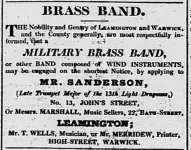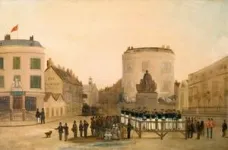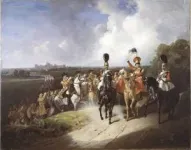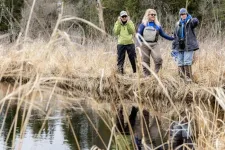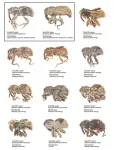(Press-News.org) University of Cambridge media release
Britain’s brass bands older than we thought and invented by soldiers from the Napoleonic Wars, new study reveals
UNDER STRICT EMBARGO UNTIL 00:01 AM (UK TIME) ON WEDNESDAY 30TH OCTOBER 2024
Military musicians returning from the Napoleonic wars established Britain’s first brass bands earlier than previously thought, new research reveals. The study undermines the idea that brass bands were a civilian and exclusively northern creation.
It is widely believed that brass bands originated with coal miners and other industrial communities in northern England and Wales between the 1830s and the 1850s. New evidence rewrites this history.
A University of Cambridge historian has found compelling evidence to show that Britain’s earliest brass bands were founded by military musicians in the 1810s.
In a study published today in The Historical Journal, Dr Eamonn O'Keeffe argues that regimental bands first experimented with all-brass formats in the aftermath of the Napoleonic Wars.
While wartime bands included woodwind instruments such as clarinets and bassoons, O’Keeffe points out that the 15th Regiment of Foot had already organized a bugles-only band by 1818 and that numerous regiments had established all-brass bands by 1830, taking advantage of new instrument designs developed at home and in Continental Europe. The Life Guards, for example, performed on valved trumpets gifted by the Russian Czar. Local defence units also mustered brass bands, including a volunteer rifle corps in Paisley (1819) and yeomanry troops in Devon (1827) and Somerset (1829).
O’Keeffe also shows that veterans of the Napoleonic wars founded many of Britain’s earliest non-military brass bands from the 1820s onwards. These ensembles often emerged far beyond the northern English and Welsh industrial communities with which they later became associated.
The first named civilian band which O’Keeffe has identified, the Colyton Brass Band, played God Save the King in a village in Devon in November 1828 as part of birthday festivities for a baronet's son. O’Keeffe found slightly later examples in Chester and Sunderland (both 1829), Derby and Sidmouth (1831), and Poole (1832). In 1834, Lincoln’s brass band was being trained by William Shaw, ‘formerly trumpeter and bugleman’ in the 33rd Regiment of Foot.
“These findings illustrate just how deeply brass bands are embedded in British history and culture,” said Dr O’Keeffe, who is the National Army Museum Junior Research Fellow at Queens' College, Cambridge and part of the University’s Centre for Geopolitics.
“We already knew about their relationship with industrialization. Now we know that brass bands emerged from Britain’s wars against Napoleon.”
O’Keeffe discovered most about a band founded by James Sanderson, a Waterloo veteran, in Leamington Spa, Warwickshire. Sanderson, a former trumpet-major, publicized his ‘military brass band’ in the Leamington Spa Courier in February 1829. Surviving newspaper reports from that summer reveal that the outfit, equipped with keyed bugles, trumpets, French horns, and trombones, performed at several well-attended fetes and other events in the area.
Sanderson’s military pension describes him as a labourer born in Thrapston, Northamptonshire. He joined the 23rd Light Dragoons, a cavalry regiment, in 1809, fought at the Battle of Waterloo in 1815 and went on to become the trumpet-major of the 13th Light Dragoons. He left the army due to epileptic fits in the 1820s.
On 29th June 1829, the Leamington Spa Courier reported that ‘Sanderson's Warwick and Leamington Military Brass Band’ performed at a Waterloo anniversary parade in Warwick. Wearing his Waterloo medal, Sanderson mustered his fellow veterans to the tune of ‘See the conquering hero comes’. On 1st July, the Leicester Herald reported that Sanderson's band played for up to 300 people at a village feast in Stoneleigh, Warwickshire, inspiring a ‘merry dance’.
War and peace
O’Keeffe points out that the Napoleonic Wars (1793 – 1815) led to a dramatic proliferation of British military bands. By 1814, more than twenty thousand instrumentalists were serving in uniform, in the regular army and militia, as well as a host of part-time home defence formations.
Most of those in full-time service received higher pay than regular soldiers but were still subject to military discipline. The majority were fifers, drummers, trumpeters and buglers, whose music conveyed commands while enhancing parade-ground pageantry and morale. The remainder served in regimental bands of music, which not only enlivened military ceremonies but performed at a wide variety of public occasions, including balls, concerts, and civic processions.
By studying previously overlooked press reports, memoirs and regimental records, O’Keeffe reveals that once demobilized, men and boys who honed their instrumental skills in uniform embarked on a variety of civilian musical careers, becoming instructors, wind performers, composers, and even opera singers.
Many performed in an array of militia and volunteer bands that remained active long after demobilization. Others instructed or participated in a growing assortment of amateur wind and all-brass bands, which often sported uniforms and consciously emulated their regimental equivalents.
O’Keeffe said: “It is widely assumed that brass bands were a new musical species, distinct from their military counterparts. They are primarily seen as a product of industrialization pioneered by a combination of working-class performers and middle-class sponsors.
“But all-brass bands first appeared in Britain and Ireland in a regimental guise. As well as producing a large cohort of band trainers, the military provided a familiar and attractive template for amateur musicians and audiences. This coincided with expanding commercial opportunities and a growing belief in the moralising power of music.”
O’Keeffe argues that these quasi-martial troupes enjoyed cross-class appeal, becoming fixtures of seaside resorts, pitheads, and political demonstrations in the decades after Waterloo, and were not confined to northern English industrial towns.
“Soldiers returned from the Napoleonic wars amidst a severe economic recession and many suffered a great deal,” O’Keeffe said. “But here we see musicians using the skills they developed in the military to survive and often thrive.”
Instruments
The Napoleonic wars created unprecedented demand for brass and other musical instruments. As well as tracking down individual musicians and bands, O’Keeffe investigated the circulation of regimental instruments after the Battle of Waterloo.
Government-issued drums and bugles were supposed to return to public stores on demobilization and band instruments generally belonged to regimental officers. But drummers and bandsmen were often unwilling to relinquish the tools of their trade.
Seven Herefordshire local militia musicians petitioned their colonel in 1816 ‘to make us a present’ of their regimental instruments, noting that performers in other disbanded units had been permitted to keep their instruments ‘as a perquisite’. The men promised to continue their weekly practices if the request was granted, pledging that ‘a band will be always ready in the town of Leominster for any occasion’.
Some officers auctioned off the instruments of their disbanded corps, making large volumes of affordable second-hand instruments available to amateur players and civilian bands in the post-war decades.
Early brass bands also embraced new instrument designs adopted by their military counterparts or introduced by regimental and ex-regimental performers. The keyed bugle, patented by an Irish militia bandmaster in 1810, was widely used by the first generation of all-brass ensembles. The popularization of affordable and uncomplicated saxhorns by the Distin family further aided the spread of brass bands from the 1840s. The family’s patriarch, John Distin, had begun his musical career in the wartime militia.
Enduring tunes
O’Keeffe identifies a number of tunes originating in the military that remained popular with the broader public long after Waterloo.
Theatre critics in the 1820s decried the nation’s love of ‘Battle Sinfonias’ and the ‘modern mania for introducing military bands on the stage’. ‘The Downfall of Paris’, a favourite regimental quick march, became a mainstay of buskers in post-war London. A music critic writing in 1827 lamented the neglect of Bach and Mozart in favour of this tune, which he said every piano instructor ‘must be able to play, and moreover to teach’.
But recalling his youth in Richmond, North Yorkshire in the 1820s and 1830s, Matthew Bell described the expert militia band as a ‘very popular’ source of free entertainment for poorer townspeople and claimed it aroused ‘a slumbering talent for music in some of those who heard its martial and inspiring strains.’
Writing in 1827, the Newcastle historian Eneas Mackenzie was clear that ‘The bands attached to the numerous military corps embodied during the late war have tended greatly to extend the knowledge of music. At present, there is a band belonging to almost every extensive colliery upon the Tyne and the Wear’.
O’Keeffe said: “Brass bands enabled aspiring musicians of all ages to develop new skills and allowed people to make music as a community, learning from each other. That was the case in the nineteenth century and it’s still the case today.”
Dr O’Keeffe is writing a book about British military music during the Napoleonic Wars.
References
E. O’Keeffe, ‘British Military Music and the Legacy of the Napoleonic Wars’, The Historical Journal (2024). DOI : 10.1017/S0018246X24000372
Media contacts
Tom Almeroth-Williams, Communications Manager (Research), University of Cambridge: researchcommunications@admin.cam.ac.uk / tel: +44 (0) 7540 139 444
Eamonn O’Keeffe, Queens’ College, University Cambridge: ewo21@cam.ac.uk
END
Britain’s brass bands older than we thought and invented by soldiers from the Napoleonic Wars, new study reveals
2024-10-30
ELSE PRESS RELEASES FROM THIS DATE:
The Lancet: Health threats of climate change reach record-breaking levels, as experts call for trillions of dollars spent on fossil fuels to be redirected towards protecting people’s health, lives and
2024-10-30
The Lancet: Health threats of climate change reach record-breaking levels, as experts call for trillions of dollars spent on fossil fuels to be redirected towards protecting people’s health, lives and livelihoods
New global findings in the 8th annual indicator report of the Lancet Countdown on Health and Climate Change reveal that people in every country face record-breaking threats to health and survival from the rapidly changing climate, with 10 of 15 indicators tracking health threats reaching ...
‘Weekend warrior’ exercise pattern may equal more frequent sessions for lowering cognitive decline risk
2024-10-29
Just one or two sessions of physical activity at the weekend—a pattern of exercise dubbed ‘weekend warrior’---may be just as likely to lower the risk of cognitive decline, which can often precede dementia, as more frequent sessions, concludes research published online in the British Journal of Sports Medicine.
And it may be more convenient and achievable for busy people as well, suggest the researchers.
It’s important to identify potentially modifiable risk factors for dementia because a 5-year delay in onset might halve its prevalence, they say, adding that nearly all the evidence to date comes from studies ...
Physical activity of any intensity linked to lower risk of death after dementia diagnosis
2024-10-29
Physical activity of any intensity after a diagnosis of dementia is associated with around a 30% lower risk of death, finds research published online in the British Journal of Sports Medicine.
The findings prompt the researchers to conclude that those affected should be encouraged to keep up or start an exercise routine, especially as average life expectancy after a diagnosis of dementia may be only around 4-5 years.
Previously published research has linked physical activity with a lower risk of death in people with the disease, but these studies have focused on a single point in time. So it’s not clear if changes in the amount or intensity of physical ...
Brain changes seen in lifetime cannabis users may not be causal
2024-10-29
Lifetime cannabis use is associated with several changes in brain structure and function in later life, suggests an observational study, but these associations may not be causal, finds a genetic analysis of the same data, published in the open access journal BMJ Mental Health.
Some other unidentified factors may explain the differences found, say the researchers, who nevertheless emphasise that further research is needed to fully understand the effects of heavy use and cannabis potency on the brain.
Cannabis use has increased worldwide following its ...
For the love of suckers: Volunteers contribute to research on key freshwater fishes
2024-10-29
A new paper published today, led by Chicago’s Shedd Aquarium, reveals how volunteers across Illinois, Wisconsin and Michigan enabled researchers to gather seven years of data on the spawning migrations of suckers, an understudied yet essential group of freshwater fishes. Using observations collected by trained members of the public, the collaborative team of researchers have discovered that temperature is the primary trigger for sucker spawning migration, which can help inform conservation strategies in light of a changing climate.
“We believe that conservation of native, non-game fishes ...
Bill and Mary Anne Dingus commit $1M to fund Human Impacts on the Earth Fund at Rice
2024-10-29
Bill Dingus ’81, a Rice University alumnus, and his wife Mary Anne have pledged $1 million to support the university’s Human Impacts on the Earth Fund, dedicated to mitigating and addressing the negative environmental effects caused by human activities on the planet. Additionally, the Dingus family is matching other donors’ contributions to the fund up to $250,000.
The Dingus’ donation enables the launch of the Earth and Planetary Opportunities in Research (EXPLORE) program, a new initiative offered through the Department of Earth, Environmental and Planetary Sciences (EEPS) that allows undergraduates of any major hands-on experience in research projects ...
Most patients can continue GLP-1 anti-obesity drugs before surgery
2024-10-29
Most patients may continue to safely take glucagon-like peptide-1 (GLP-1) receptor agonists as prescribed before undergoing elective surgery and gastrointestinal endoscopies, according to new clinical guidance released today by five surgical and medical societies including the American Society for Metabolic and Bariatric Surgery (ASMBS), American Society of Anesthesiologists (ASA), American Gastroenterological Association (AGA), International Society of Perioperative Care of Patients with Obesity (ISPCOP), and Society of American Gastrointestinal and Endoscopic Surgeons (SAGES).
The guidance, published online in Surgery for Obesity and Related Diseases ...
Computational tool developed to predict immunotherapy outcomes for patients with metastatic breast cancer
2024-10-29
FOR IMMEDIATE RELEASE
Using computational tools, researchers from the Johns Hopkins Kimmel Cancer Center and the Johns Hopkins University School of Medicine have developed a method to assess which patients with metastatic triple-negative breast cancer could benefit from immunotherapy. The work by computational scientists and clinicians was published Oct. 28 in the Proceedings of the National Academy of Sciences.
Immunotherapy is used to try to boost the body’s own immune system to attack cancer cells. However, only some patients respond to treatment, explains lead study author Theinmozhi Arulraj, Ph.D., a postdoctoral fellow at Johns Hopkins: “It’s really important ...
Cerebral embolic protection by geographic region
2024-10-29
About The Study: The PROTECTED transcatheter aortic valve replacement (TAVR) trial could not show that the use of cerebral embolic protection (CEP) had a significant effect on the incidence of periprocedural stroke during TAVR. Although there was no significant interaction by geographic region, this exploratory post hoc analysis suggests a trend toward greater stroke reduction in the U.S. cohort but not in the outside the U.S. cohort. These findings are hypothesis generating, and further research is needed to determine if regional differences in patient characteristics or procedural practices ...
12 new Oriental weevil species discovered using advanced imaging tools
2024-10-29
Jake Lewis, an entomologist in the Environmental Science and Informatics Section at the Okinawa Institute of Science and Technology (OIST), is fascinated by weevils, a diverse group of beetles that includes many species with elephant trunk-like mouthparts (called a rostrum). Weevils provide various ecosystem services such as pollination and decomposition, but some species are serious pests known to decimate crop fields and timber forests.
Using x-ray microtomography, a 3D imaging technique ...
